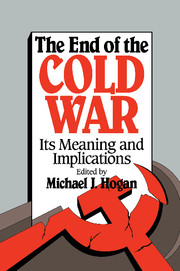Book contents
- Frontmatter
- Contents
- Preface
- The Authors
- Dedication
- 1 Introduction
- 2 An End to Which Cold War?
- 3 The Cold War, the Long Peace, and the Future
- 4 Quiet Cataclysm: Some Afterthoughts on World War III
- 5 Some Lessons from the Cold War
- 6 Nuclear Weapons and European Security during the Cold War
- 7 Victory in the Postwar Era: Despite the Cold War or Because of It?
- 8 The Wicked Witch of the West is Dead. Long Live the Wicked Witch of the East
- 9 The End and the Begining
- 10 A Balance Sheet: Lippmann, Kennan, and the Cold War
- 11 Why Did the Cold War Arise, and Why Did It End?
- 12 A View from Below
- 13 The End of the Cold War and the Middle East
- 14 The End of the Cold War in the Near East: What It Means for Historians and Policy Planners
- 15 After the Cold War: The United States, Germany, and European Security
- 16 The End of the Cold War: A Skeptical View
- 17 The End of the Cold War, the New Role for Europe, and the Decline of the United States
- 18 The Fading of the Cold War—and the Demystification of Twentieth-Century Issues
- 19 The U.S. Government, a Legacy of the Cold War
- 20 Foreign Policy, Partisan Politics, and the End of the Cold War
- 21 Beyond Bipolarity in Space and Time
- 22 A Usable Past for the Future
- Selective Bibliography
- Index
19 - The U.S. Government, a Legacy of the Cold War
Published online by Cambridge University Press: 18 December 2009
- Frontmatter
- Contents
- Preface
- The Authors
- Dedication
- 1 Introduction
- 2 An End to Which Cold War?
- 3 The Cold War, the Long Peace, and the Future
- 4 Quiet Cataclysm: Some Afterthoughts on World War III
- 5 Some Lessons from the Cold War
- 6 Nuclear Weapons and European Security during the Cold War
- 7 Victory in the Postwar Era: Despite the Cold War or Because of It?
- 8 The Wicked Witch of the West is Dead. Long Live the Wicked Witch of the East
- 9 The End and the Begining
- 10 A Balance Sheet: Lippmann, Kennan, and the Cold War
- 11 Why Did the Cold War Arise, and Why Did It End?
- 12 A View from Below
- 13 The End of the Cold War and the Middle East
- 14 The End of the Cold War in the Near East: What It Means for Historians and Policy Planners
- 15 After the Cold War: The United States, Germany, and European Security
- 16 The End of the Cold War: A Skeptical View
- 17 The End of the Cold War, the New Role for Europe, and the Decline of the United States
- 18 The Fading of the Cold War—and the Demystification of Twentieth-Century Issues
- 19 The U.S. Government, a Legacy of the Cold War
- 20 Foreign Policy, Partisan Politics, and the End of the Cold War
- 21 Beyond Bipolarity in Space and Time
- 22 A Usable Past for the Future
- Selective Bibliography
- Index
Summary
In Westminster, the houses of Parliament and Buckingham Palace—both structures of the Victorian era—and the Georgian and Regency offices along Whitehall are buildings for a seat of empire, not for the capital of a middle-ranking member of the European Community. The drab, modest government office blocks of Tokyo and Bonn seem equally ill-suited, given that they serve the second and third ranking powers of the economic world. None of these capitals vies with Vienna, where the magnificent Hofburg is the seat of government for a republic smaller than Indiana, but in all of them form and function seem mismatched. them form and function seem mismatched.
Before long, if not already, Washington, DC, may also seem a capital where form and function are not in kilter. A tour of today's action centers starts at the White House. One sees the West Wing and the Old Executive Office Building next door, the quarters of the president's National Security Council (NSC). The tour goes onto the squat, plain New State Department building on Twenty-firstStreet, where the building directory lists numerous bureaus andsubbureaus for politico-military affairs. It also lists the autonomousArms Control and Disarmament Agency. Across the Potomac, a visitor sees the Pentagon. With a daytimepopulation of twenty-five thousand, it is the crest of a mountainousdefense establishment, which employs almost two thirds of thenearly five million persons who work for the U.S. government.Farther out in Virginia, at Langley, the Central Intelligence Agency(CIA) has more office acreage than the Pentagon. At Fort Meadein Maryland sits the even larger, more mysterious, and more ex-pensive National Security Agency, engaged in encrypting and decrypting signals.
- Type
- Chapter
- Information
- The End of the Cold WarIts Meaning and Implications, pp. 217 - 228Publisher: Cambridge University PressPrint publication year: 1992
- 2
- Cited by



